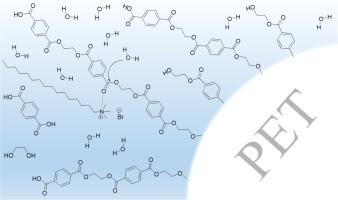Neutral hydrolysis of post-industrial PET waste: Cetyltrimethylammonium bromide (CTAB)-catalyzed and catalyst-free reactions
IF 7.4
2区 化学
Q1 POLYMER SCIENCE
引用次数: 0
Abstract
Polyethylene terephthalate (PET) is one of the most widely used polymers globally, thus generating a significant amount of waste each year. Chemical recycling is an effective method for converting PET waste into its monomeric constituents. In this study, the hydrolysis of a PET waste generated in an industrial production line was investigated. The hydrolysis process was carried out in the presence of cetyltrimethylammonium bromide (CTAB) as a catalyst. The Taguchi L18 design was employed to evaluate the effects of three key parameters: temperature, reaction time, and the CTAB:PET mass ratio. Analysis of variance (ANOVA) was also conducted to assess the statistical significance of these parameters. The results showed that the highest terephthalic acid yield (90.44 %) was achieved at 215 °C, 90 min, and 5.0 wt% catalyst, while a yield of 95.91 % was obtained at 220 °C, 90 min, without a catalyst. Statistical analysis indicated that temperature had the most significant impact on hydrolysis efficiency, followed by reaction time, and catalyst loading. The calculated environmental energy impacts (ξ) for these optimal reactions are 9.6 × 103 and 7.5 × 103 °C·min, for the 215 and 220 °C, respectively, that are fairly low compared to other neutral hydrolysis reports. To confirm the structural composition and purity of the reaction products, Fourier-transform infrared spectroscopy, nuclear magnetic resonance, X-ray diffraction analysis, and thermogravimetric analysis were performed.

工业后PET废弃物的中性水解:十六烷基三甲基溴化铵(CTAB)催化和无催化剂反应
聚对苯二甲酸乙二醇酯(PET)是全球使用最广泛的聚合物之一,因此每年产生大量废物。化学回收是将PET废弃物转化为其单体组分的有效方法。在本研究中,研究了在工业生产线上产生的PET废料的水解。在十六烷基三甲基溴化铵(CTAB)的催化下进行了水解。采用Taguchi L18设计来评价温度、反应时间和CTAB:PET质量比三个关键参数的影响。并进行方差分析(ANOVA)来评估这些参数的统计学意义。结果表明,在215℃,90 min, 5.0 wt%催化剂条件下,对苯二甲酸收率最高,为90.44%;在220℃,90 min,无催化剂条件下,对苯二甲酸收率最高,为95.91%。统计分析表明,温度对水解效率的影响最为显著,其次是反应时间和催化剂负载。在215°C和220°C条件下,计算出的这些最佳反应的环境能量影响(ξ)分别为9.6 × 103和7.5 × 103°C·min,与其他中性水解报道相比,这是相当低的。为了确定反应产物的结构组成和纯度,进行了傅里叶变换红外光谱、核磁共振、x射线衍射分析和热重分析。
本文章由计算机程序翻译,如有差异,请以英文原文为准。
求助全文
约1分钟内获得全文
求助全文
来源期刊

Polymer Degradation and Stability
化学-高分子科学
CiteScore
10.10
自引率
10.20%
发文量
325
审稿时长
23 days
期刊介绍:
Polymer Degradation and Stability deals with the degradation reactions and their control which are a major preoccupation of practitioners of the many and diverse aspects of modern polymer technology.
Deteriorative reactions occur during processing, when polymers are subjected to heat, oxygen and mechanical stress, and during the useful life of the materials when oxygen and sunlight are the most important degradative agencies. In more specialised applications, degradation may be induced by high energy radiation, ozone, atmospheric pollutants, mechanical stress, biological action, hydrolysis and many other influences. The mechanisms of these reactions and stabilisation processes must be understood if the technology and application of polymers are to continue to advance. The reporting of investigations of this kind is therefore a major function of this journal.
However there are also new developments in polymer technology in which degradation processes find positive applications. For example, photodegradable plastics are now available, the recycling of polymeric products will become increasingly important, degradation and combustion studies are involved in the definition of the fire hazards which are associated with polymeric materials and the microelectronics industry is vitally dependent upon polymer degradation in the manufacture of its circuitry. Polymer properties may also be improved by processes like curing and grafting, the chemistry of which can be closely related to that which causes physical deterioration in other circumstances.
 求助内容:
求助内容: 应助结果提醒方式:
应助结果提醒方式:


